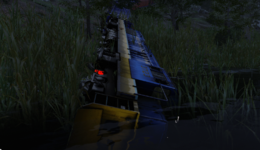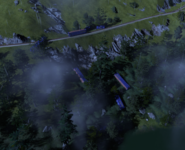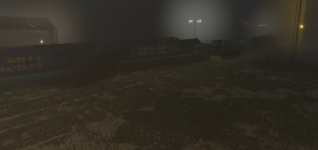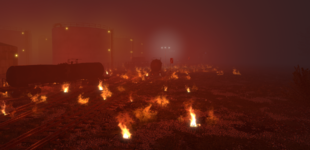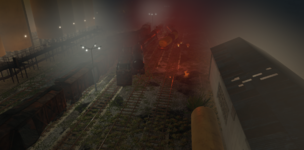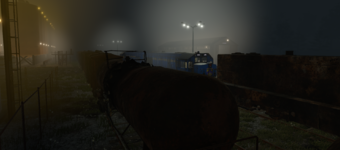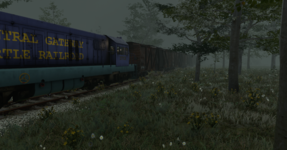Central Gateway Turtle Railroad: Difference between revisions
No edit summary |
No edit summary |
||
| (2 intermediate revisions by the same user not shown) | |||
| Line 17: | Line 17: | ||
|marks = [[CGTR]] (main locomotives/rolling stock), [[GTLW]] (locomotive manufacturing), [[GTLX]] (GTLW leasing units), [[TRTM]] (TurtleTram locomotives/rolling stock), [[GTCO]] (intermodal/cross-network), [[GTRC]] (locomotive/railcar leasing) | |marks = [[CGTR]] (main locomotives/rolling stock), [[GTLW]] (locomotive manufacturing), [[GTLX]] (GTLW leasing units), [[TRTM]] (TurtleTram locomotives/rolling stock), [[GTCO]] (intermodal/cross-network), [[GTRC]] (locomotive/railcar leasing) | ||
|locale = North America | |locale = North America | ||
| | |founded = {{Start date and age|1898|06|19}} | ||
|end_year = {{End date|Present}} | |end_year = {{End date|Present}} | ||
|predecessor = {{Collapsible list | |predecessor = {{Collapsible list | ||
| Line 48: | Line 48: | ||
|parent = [[Gateway Turtle Company]] | |parent = [[Gateway Turtle Company]] | ||
}} | }} | ||
{{CGTR}} | |||
The [[Central Gateway Turtle Railroad]] ({{wp|Reporting mark}}s [[Central Gateway Turtle Railroad|CGTR]], [[Gateway Turtle Locomotive Works|GTLW]], [[Gateway Turtle Locomotive Works Leasing|GTLX]], [[TurtleTram|TRTM]], [[Gateway Turtle Company|GTCO]]) is a prominent {{wp|Railroad_classes#Class_I|Class I}} North American passenger and freight railroad, owned by the [[Gateway Turtle Company]]. Its operational footprint primarily covers the Southern, Eastern, and Central regions of the United States, with its headquarters located in {{wp|Fort Worth}}, {{wp|Texas}}. As a major {{wp|Railroad_classes#Class_I|Class I}} railroad, the [[Central Gateway Turtle Railroad]] assumes a critical role in transporting substantial freight volumes across its extensive network. Its intricate infrastructure and logistics system contribute to the effective movement of goods within the serviced regions. | The [[Central Gateway Turtle Railroad]] ({{wp|Reporting mark}}s [[Central Gateway Turtle Railroad|CGTR]], [[Gateway Turtle Locomotive Works|GTLW]], [[Gateway Turtle Locomotive Works Leasing|GTLX]], [[TurtleTram|TRTM]], [[Gateway Turtle Company|GTCO]]) is a prominent {{wp|Railroad_classes#Class_I|Class I}} North American passenger and freight railroad, owned by the [[Gateway Turtle Company]]. Its operational footprint primarily covers the Southern, Eastern, and Central regions of the United States, with its headquarters located in {{wp|Fort Worth}}, {{wp|Texas}}. As a major {{wp|Railroad_classes#Class_I|Class I}} railroad, the [[Central Gateway Turtle Railroad]] assumes a critical role in transporting substantial freight volumes across its extensive network. Its intricate infrastructure and logistics system contribute to the effective movement of goods within the serviced regions. | ||
| Line 270: | Line 271: | ||
==Liveries== | ==Liveries== | ||
===Bluewashed=== | ===Bluewashed=== | ||
[[File:Trainiax CGTR Bluewashed B36-7.png|thumb|left|400px|A Trainiax GE B36-7 in CGTR Bluewashed Scheme]]<br clear=all> | [[File:Trainiax CGTR Bluewashed B36-7.png|thumb|left|400px|A Trainiax GE B36-7 in CGTR Bluewashed Scheme]]<br clear=all> | ||
| Line 278: | Line 277: | ||
[[File:Trainiax CGTR Bluelined FP45.png|thumb|left|400px|A Trainiax EMD FP45 in CGTR Bluelined scheme.]]<br clear=all> | [[File:Trainiax CGTR Bluelined FP45.png|thumb|left|400px|A Trainiax EMD FP45 in CGTR Bluelined scheme.]]<br clear=all> | ||
The Bluelined scheme was a CGTR scheme used on passenger locomotives that was first seen in the late 1960s to 1970s, appearing on the new {{wp|EMD FP45}} in 1967, the new {{wp|EMD F40PH}} in 1976, and being repainted onto the older {{wp|EMD E7}}s, {{wp|ALCO PA-2}}s, and {{wp|EMD E8}}s, in the early 1970s. The scheme would remain on most of its locomotives until their retirements, as many of them were becoming outdated. The scheme would be replaced in | The Bluelined scheme was a CGTR scheme used on passenger locomotives that was first seen in the late 1960s to 1970s, appearing on the new {{wp|EMD FP45}} in 1967, the new {{wp|EMD F40PH}} in 1976, and being repainted onto the older {{wp|EMD E7}}s, {{wp|ALCO PA-2}}s, and {{wp|EMD E8}}s, in the early 1970s. The scheme would remain on most of its locomotives until their retirements, as many of them were becoming outdated. The scheme would be replaced in | ||
===Tealwave=== | |||
[[File:Trainiax CGTR Tealwave C-424.png|thumb|left|400px|A Trainiax ALCo C-424 in CGTR Tealwave scheme.]]<br clear=all> | |||
The Tealwave scheme is often seen as the most iconic CGTR scheme, with most of the company's locomotives bearing the scheme at one point throughout their service. The scheme is similar in design to the Bluelined scheme, however a notable difference is that the standard yellow on this scheme is replaced with the teal of the Bluewashed scheme. | |||
===Hydrogold=== | ===Hydrogold=== | ||
===Golden Ember=== | ===Golden Ember=== | ||
===Thundering Lapis=== | ===Thundering Lapis=== | ||
| Line 289: | Line 287: | ||
====Phase III==== | ====Phase III==== | ||
====Phase IV==== | ====Phase IV==== | ||
===GT&SF=== | |||
====Patch Schemes==== | |||
====Goldlined==== | |||
==See Also== | ==See Also== | ||
*[[Gateway Turtle Locomotive Works]] | *[[Gateway Turtle Locomotive Works]] | ||
Latest revision as of 03:00, 7 April 2024
This article is incomplete, as it is a part of a work-in-progress series of articles covering the fictional railroad CGTR and related topics. This article is being worked on by user SwedishTurtles, and may be temporarily missing information. Please comment on this article's talk page to share your input, comments and questions. Note: To contribute to this article, you may need to seek help from the author(s) of this page. |
 | |
 CGTR #3723, a Hydrogold livery GE U25C in 1973 (enhanced). | |
| Reporting mark | CGTR (main locomotives/rolling stock), GTLW (locomotive manufacturing), GTLX (GTLW leasing units), TRTM (TurtleTram locomotives/rolling stock), GTCO (intermodal/cross-network), GTRC (locomotive/railcar leasing) |
|---|---|
| Predecessor | List
|
| Founded | June 19, 1898 |
| Track gauge | 4 ft 8 1⁄2 in (1,435 mm) standard gauge |
| Electrification | 12.5 kV 25 Hz AC, overhead line, third rail (TurtleTram trackage) |
| Parent | Gateway Turtle Company |
| Website | cgtr |
| This article is part of a series on the |
| CGTR |
|---|
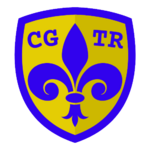 |
The Central Gateway Turtle Railroad (Reporting marks CGTR, GTLW, GTLX, TRTM, GTCO) is a prominent Class I North American passenger and freight railroad, owned by the Gateway Turtle Company. Its operational footprint primarily covers the Southern, Eastern, and Central regions of the United States, with its headquarters located in Fort Worth, Texas. As a major Class I railroad, the Central Gateway Turtle Railroad assumes a critical role in transporting substantial freight volumes across its extensive network. Its intricate infrastructure and logistics system contribute to the effective movement of goods within the serviced regions.
History
GAEA-TRLN Era
Establishment of the Eastern Gateway Turtle Railroad
The Eastern Gateway Turtle Railroad was established on July 24th, 1874, following the merger of the Gateway Eastern Railway and the Turtle Northern Railway. This collaborative effort was a response to the economic uncertainties triggered by the Panic of 1873, and it sought to create a more robust and streamlined rail network.
Distinguished by its commitment to excellence, the EGTR rapidly gained prominence for delivering impeccable passenger and freight services across the Northeastern United States. The railroad became synonymous with reliability and efficiency, earning the trust of both passengers and businesses alike.
As the network expanded, the Eastern Gateway Turtle Railroad played a pivotal role in connecting communities and facilitating commerce. Its reputation for punctuality and top-notch services solidified its position as a go-to choice for transportation needs. The legacy of the Eastern Gateway Turtle Railroad extended far beyond its formation, leaving an indelible mark on the landscape of rail transportation in the late 19th century.
EGTR-QZCL Era
Queztal Central Merger
On June 19th, 1898, the Eastern Gateway Turtle Railroad would absorb the near-bankrupt Quetzal Central Lines, forming the Central Gateway Turtle Railroad. This would be a major event, as both railroads were rather large at this time, so the merger created a massive rail network.
Early Dieselization
Full Transition
Early Expansion and Acquisition
Monon Railroad
Ann Arbor Railroad
On September 27th, 1972, the CGTR-AA merger would be finalized, making the Ann Arbor Railroad the second Class I railroad absorbed by CGTR in the 1970s. The railroad's locomotives would be transferred and placed onto CGTR's roster, and the ownership of the tracks would be transferred to CGTR as well.
Central Railroad of New Jersey
Reading Company
Attempted ATSF Merger
Later Expansion and Acquisition
Maine Central Railroad
Boston and Maine Railroad
Missouri-Kansas-Texas Railroad
Delaware and Hudson Railway
Denver and Rio Grande Western Railroad
Missouri Pacific Railroad
Illinois Central Railroad
Burlington Northern Railroad
Norfolk Southern Railway
Incidents
Gulfport Runaway Tragedy
On the 21st of February, 1982, CGTR #3723 was hauling a 28 car iron ore train through the stormy weather near Gulfport, Mississippi. At around 4:38 AM, the locomotive was approaching a somewhat steep grade. The engineer increased the throttle, to keep the train going fast enough, and also applied the sander to account for the wet and slippery trackage. As the locomotive accelerated up the hill, the thunderstorm began to worsen. At about 4:45 AM, the thunderstorm would reach its most severe point, and the locomotive was struggling to continue to accelerate. The engineer would set the throttle to full, to attempt to overcome this. At approximately 4:56 AM, lightning would hit the locomotive, causing the cab to completely lose power. The locomotive by this time had reached the top of the hill, and was getting ready to go downhill. With the throttle being uncontrollable and already at max, the engineer attempted to stop the train by pulling the brakes. This slowed down the train momentarily, but because of the steep grade and high throttle, the train's brakes would eventually overheat and fail. The locomotive would barrel downhill, eventually going onto a relatively sharp curve in the tracks, causing the train to derail and fall into a lake. All members of the crew in the cab would be killed, however the crew members in the caboose would only experience some slight injuries.
Cleanup
Houston Ammo Train Incident
On the 20th of December, 1979, CGTR #3718 and CGTR #3709 were pulling an ammunition train for a contractor late at night. When the locomotives reached Houston, Texas, they would approach a yard primarily full of oil tankers. The locomotives were going approximately 35 MPH, but what the operators did not know was that due to a switch being flipped, the train was on the wrong track. The train would end up spotting a large oil tanker train containing mostly Procor cars on the track ahead, and attempted to brake, although they were too close to stop in time. The two locomotives would end up ramming the oil tankers, causing them all to detonate and start a large fire. The detonation of the oil tankers would trigger the explosion of the ammunition as well, and shortly after both locomotives would explode, along with the rest of the cargo.
Cleanup
CGTR #3723 and #3721 arriving to help clean up the damaged train cars after they were rerailed
After the fires arising from the train cars and locomotives would be put out by the Houston Fire Department, all cars would be rerailed and placed into several trains in the yard. Roadswitchers CGTR #3721 and CGTR #3723 would arrive shortly to couple all of the trains and transport the damaged cars to another yard, where they would be repaired and placed back into service. CGTR #3709 and CGTR #3718 would be repaired and placed back into service as well, and would remain in service until they were retired in 2000.
Michigan Thundering Lapis Runaway
CGTR #77 Derailment
Intermodal
CGTR offers a variety of intermodal services, including trucks, vans, and off-road Maintenance of way vehicles.
Equipment
Locomotives
As of late 2023, CGTR rosters over 3,500 locomotives.
| Type | Quantity | Road Numbers | Notes | Image |
|---|---|---|---|---|
| EMD F125 | 74 | 1–3, 14–25, 42–50, 300–349 | ||
| GE P32AC-DM | 35 | 4–13, 6900–6924 | ||
| EMD GP40FH-2 | 26 | 26–41, 6300–6309 | ||
| EMD F59PHI | 8 | 51–58 | ||
| MPI MP54AC | 13 | 62–74 | ||
| GTLW DAS25 | 2 | 75–76 | ||
| GTLW DAT45AB | 1 | 77 | ||
| GTLW YF2 | 18 | 200–217 | ||
| GTLW YF2B | 2 | 218, 219 | ||
| GE B23-7 | 62 | 400–461 | ||
| GE B30-7 | 78 | 500–577 | ||
| EMD GP39-2 | 31 | 600–630 | ||
| GTLW GP7-GT | 100 | 700–799 | ||
| GE C30-7 | 45 | 900–944 | Painted and remained in GTSF scheme since 1978 | |
| EMD GP40 | 40 | 1000–1039 | Painted and remained in GTSF scheme since 1981 | |
| ALCO S-4 | 8 | 1100–1107 | ||
| GTLW CFP7 | 20 | 1200–1219 | ||
| GE U18B | 10 | 1300–1309 | Painted and remained in GTSF scheme since 1981, kept ex. Maine Central names | |
| ALCO C424M | 6 | 1400–1405 | Painted and remained in GTSF scheme since 1981 | |
| EMD SDP40F | 2 | 1874A, 1874C | ||
| EMD SDP40FB | 1 | 1874B | ||
| EMD SD70M | 2 | 1898A, 1898B | ||
| EMD SD45T-2 | 2 | 1971, 1972 | ||
| EMD GP39-2 | 1 | 1974 | ||
| GE C30-7 | 1 | 1975 | ||
| EMD GP50 | 1 | 1981 | ||
| GE C39-8 | 1 | 1985 | ||
| GE C40-8 | 1 | 1988 | ||
| EMD SD70 | 1 | 1991 | ||
| EMD SD70MAC | 1 | 1992 | ||
| GE C40-9W | 1 | 1997 | ||
| GE C44-9W | 1 | 1999 | ||
| RDG 2102 | 1 | 2102 | ||
| GE U36C | 1 | 3723 | rebuilt from GE U25C after a wreck and nicknamed the "Phoenix Resilient" | |
| Quetzal Central 4602 | 1 | 4602 | ||
| GTLW SD40-GTHH | 55 | 5000–5054 | Rebuilt from SD40-2s | |
| GTLW SD40-GTS | 39 | 5064–5102 | Rebuilt from SD40-2s | |
| GTLW SD40-GT | 64 | 5116–5179 | Rebuilt from SD40-2s | |
| EMD SW1504 | 24 | 5400–5423 | ||
| EMD MP15AC | 50 | 5500–5549 | ||
| GE B23-7 | 36 | 5700–5735 | ||
| EMD GP39-2 | 17 | 5800–5816 | ||
| GE C30-7 | 22 | 5900–5921 | ||
| GE B30-7 | 78 | 6000–6077 | ||
| GE B39-8 | 20 | 6100–6119 | ||
| EMD MP15T | 20 | 6200–6219 | ||
| GE C40-8 | 40 | 6400–6439 | ||
| EMD F59PH | 33 | 6500–6532 | ||
| EMD SD60M | 50 | 6600–6649 | ||
| GE C40-8W | 70 | 6700–6769 | ||
| GE C44-9W | 50 | 6800–6849 | ||
| GE AC4400CW | 645 | 7000–7644 | ||
| GE P42DC | 30 | 7700–7729 | ||
| GE AC6000CW | 50 | 7800–7849 | ||
| EMD SD70MAC | 30 | 7900–7929 | ||
| EMD GP20D | 35 | 8000–8034 | ||
| EMD SD9043MAC | 48 | 8100–8147 | ||
| EMD SD70ACe | 308 | 8200–8457 | ||
| GE ES44DC | 300 | 8500–8799 | ||
| GE ES44AC | 455 | 8800–9254 | ||
| GE ES44C4 | 553 | 9300–9852 |
Liveries
Bluewashed
The Bluewashed scheme was a CGTR scheme used on freight and switching locomotives that was first seen in the mid 1960s and 1970s, appearing on the new GE U25Bs, EMD SW1500s, ALCO C630s, EMD SD39s, GE U33Bs, GE B36-7s, EMD F45s, EMD SD40-2 and EMD SD40T-2s, and being repainted onto the older ALCO HH1000s, EMD NW2s, Baldwin VO-660s, EMD BL2s, EMD SW9s, Baldwin RF-16s
Bluelined
The Bluelined scheme was a CGTR scheme used on passenger locomotives that was first seen in the late 1960s to 1970s, appearing on the new EMD FP45 in 1967, the new EMD F40PH in 1976, and being repainted onto the older EMD E7s, ALCO PA-2s, and EMD E8s, in the early 1970s. The scheme would remain on most of its locomotives until their retirements, as many of them were becoming outdated. The scheme would be replaced in
Tealwave
The Tealwave scheme is often seen as the most iconic CGTR scheme, with most of the company's locomotives bearing the scheme at one point throughout their service. The scheme is similar in design to the Bluelined scheme, however a notable difference is that the standard yellow on this scheme is replaced with the teal of the Bluewashed scheme.


